러웨이 선언문 - 인간과 동물과 사이보그에 관한 전복적 사유


도나 해러웨이 (지은이),황희선 (옮긴이)책세상2019-07-15원제 : Manifestly Haraway (2016년)
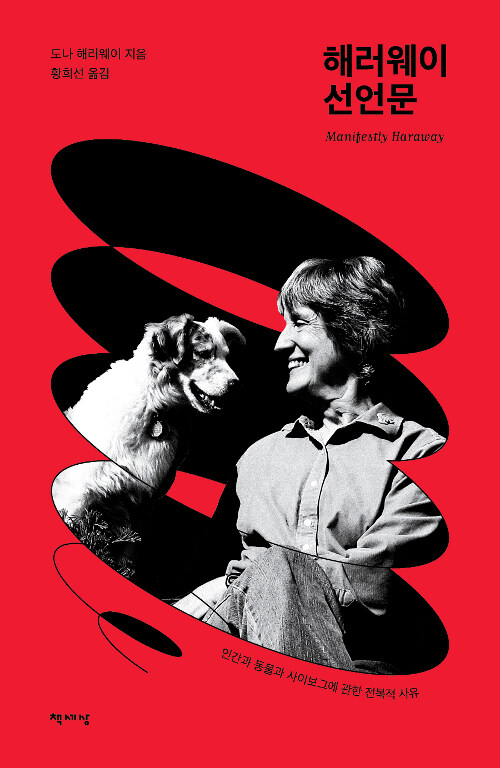
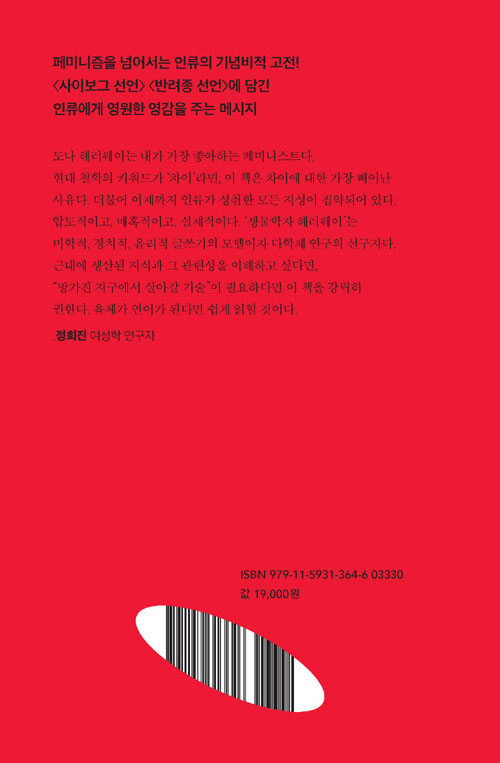





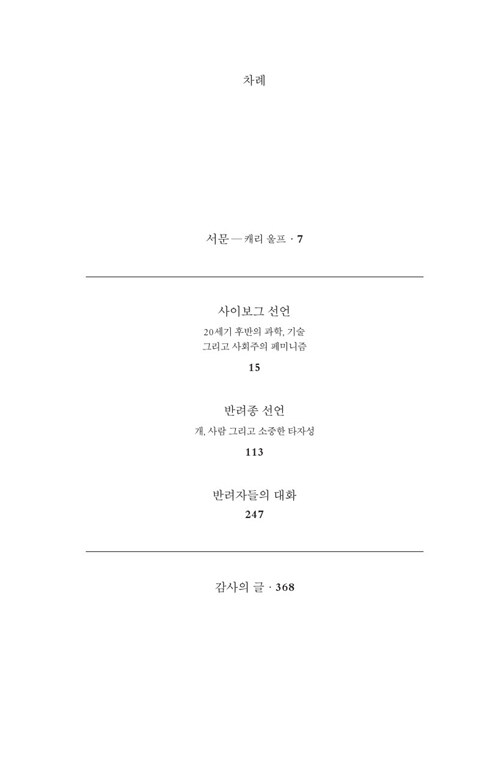


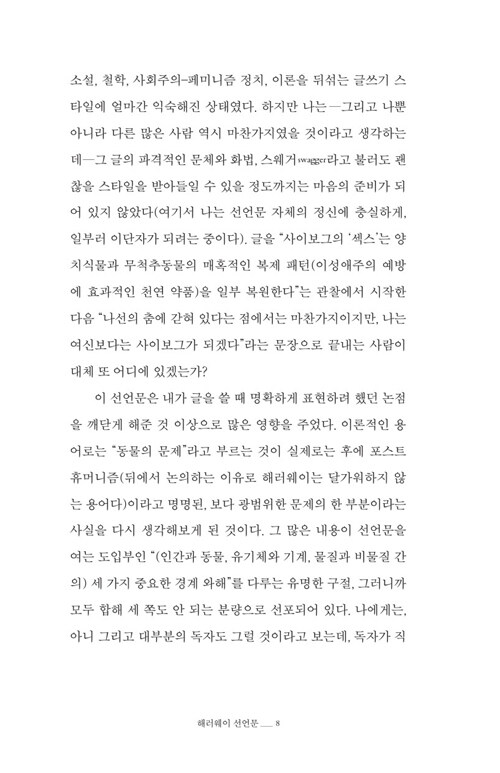

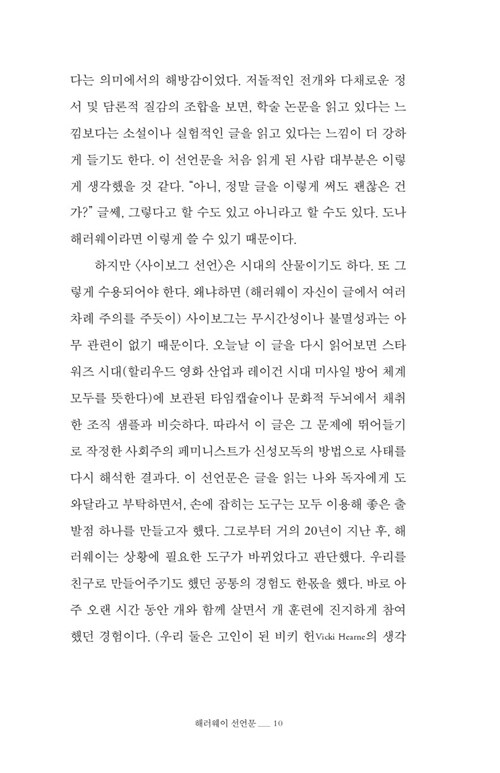

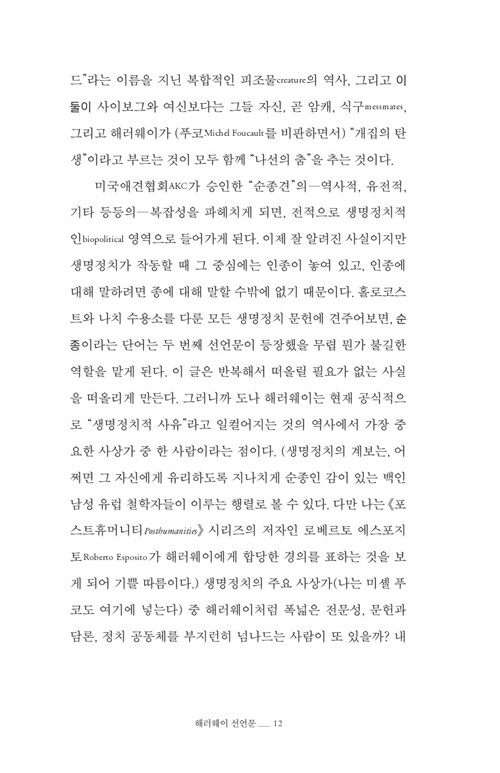

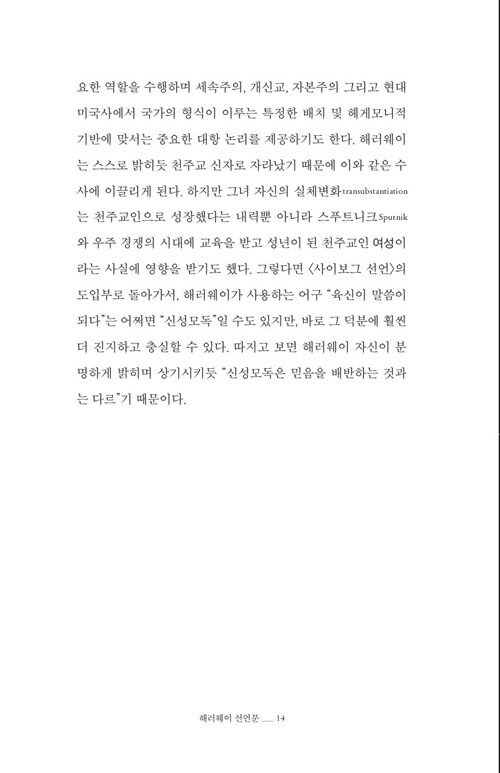


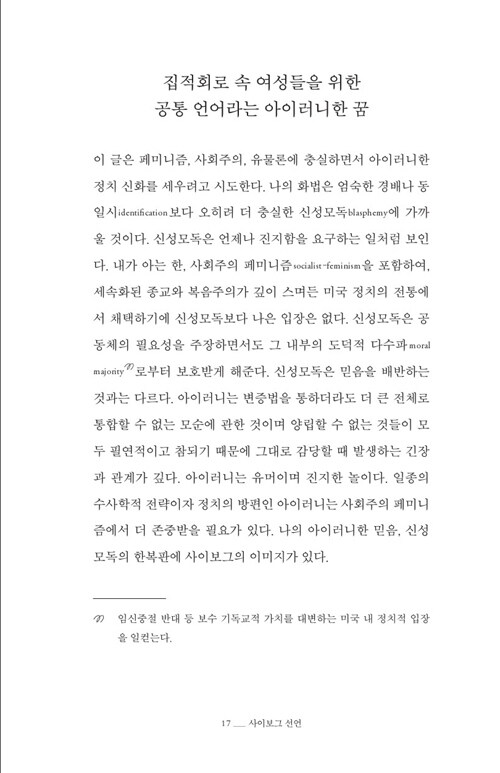
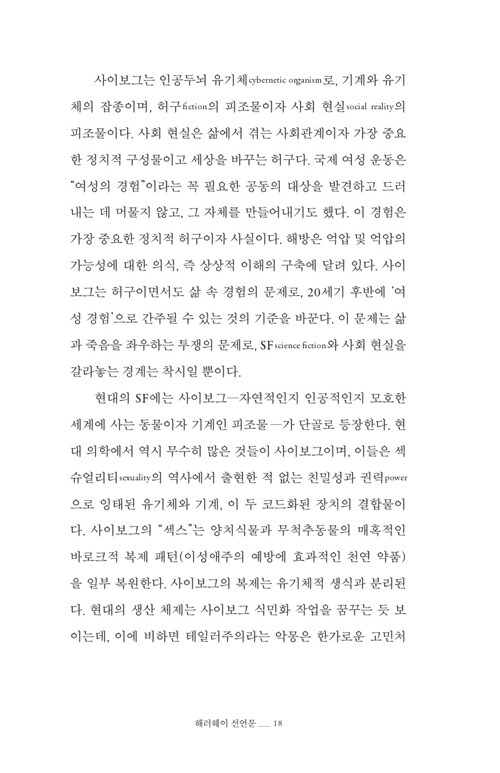
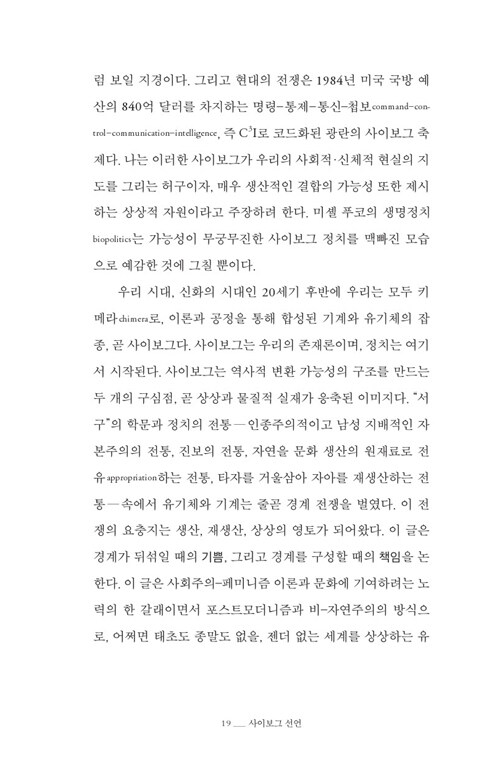
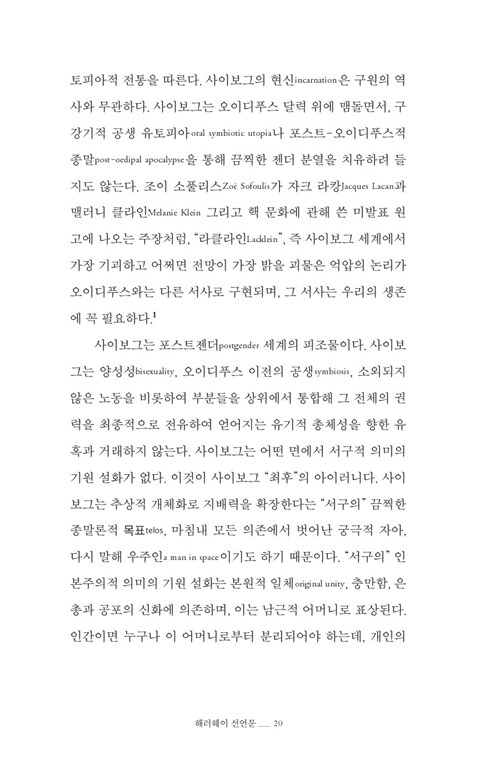
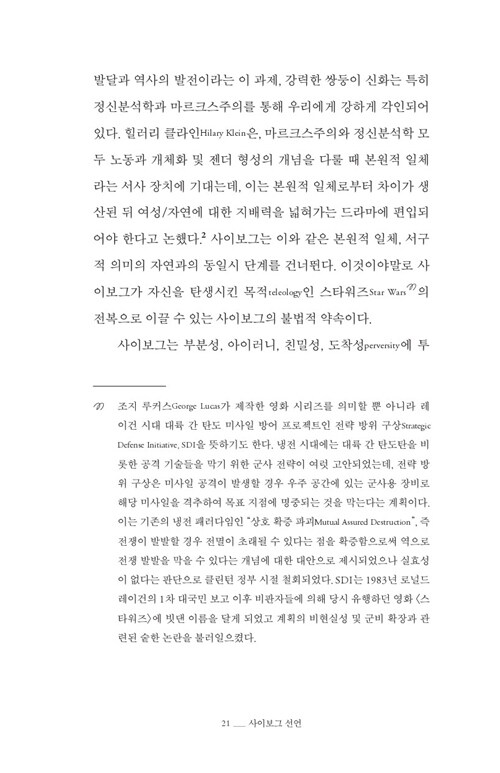


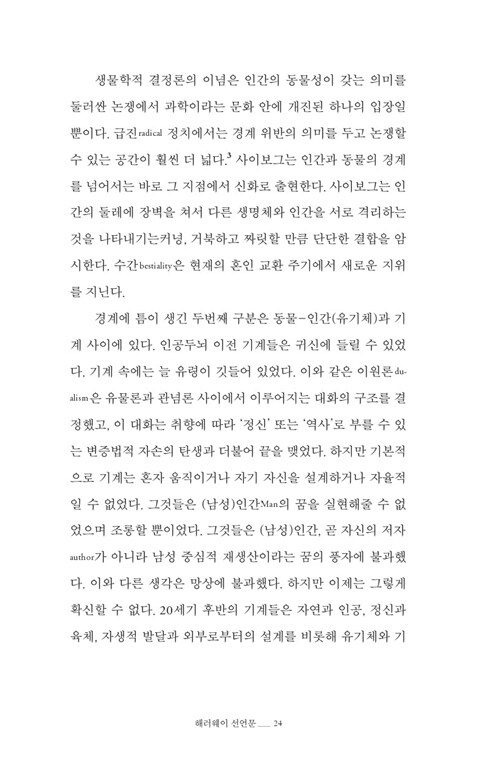
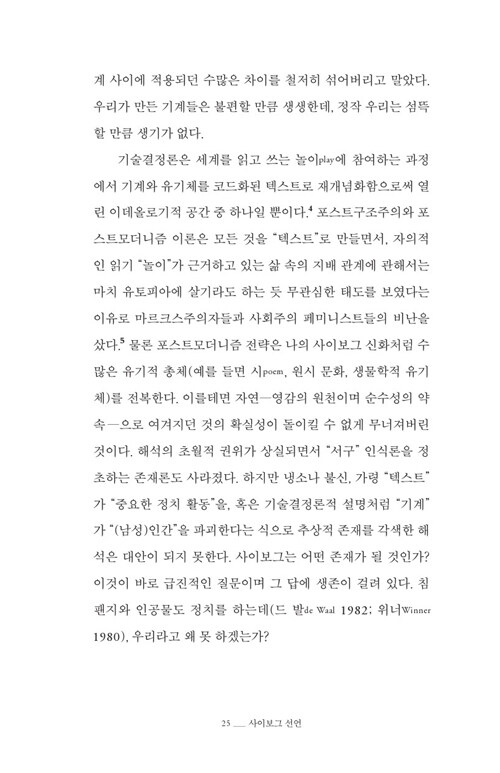
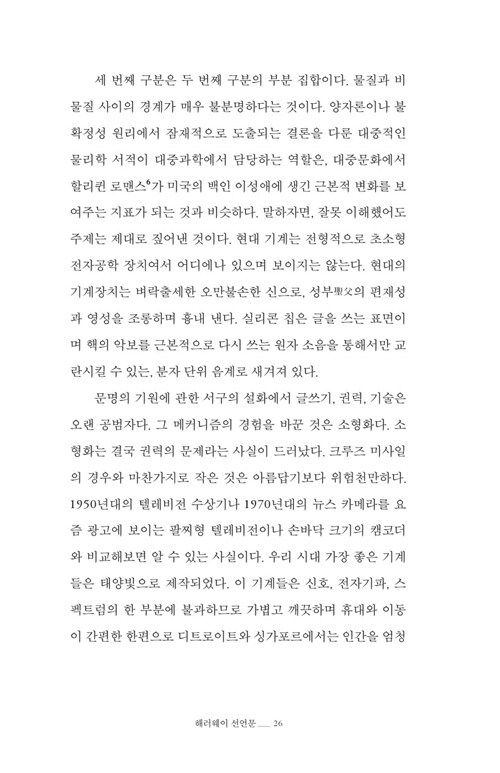
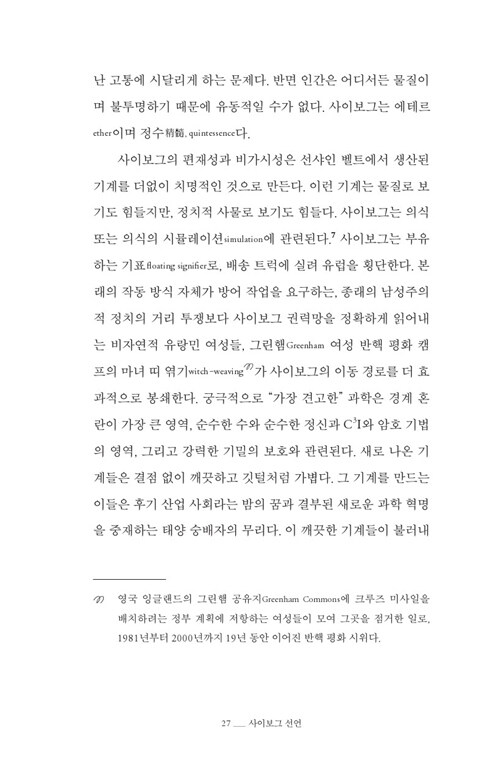



페미니스트 여행용 파우치
정가
19,000원
판매가
17,100원 (10%, 1,900원 할인)
마일리지
950원(5%) + 멤버십(3~1%)
+ 5만원이상 구매시 2,000원
세액절감액
770원 (도서구입비 소득공제 대상 및 조건 충족 시)
전자책
13,300원

이 책 어때요?
카드/간편결제 할인
무이자 할부
책소개
저명한 페미니즘 이론가 도나 해러웨이가 발표한 <사이보그 선언>(1985), <반려종 선언>(2003)과 라이스 대학 영문과 교수 캐리 울프와의 대담을 한데 모아 엮은 저작선이다. 해러웨이는 세계적인 생물학자이자 문화 비평가, 과학 및 테크놀로지 역사가이기도 하다.
저자 도나 해러웨이는 간학문적·다학문적 연구의 선구자로서, 《해러웨이 선언문》에서 여러 분야를 종횡으로 오가며 융복합적 글쓰기를 시도한다. 그런 만큼 이 책은 철학적·인류학적·문명사적 차원에서 패러다임을 바꾸는 대담한 문제제기와 선구적 혜안을 담고 있다. 페미니즘과 과학사 분야의 고전의 경지를 넘어, 인간과 동물과 사이보그에 관한 전복적 사유를 통해 인류에게 영원한 영감을 주는 저작이다.
목차
・서문 — 캐리 울프
・사이보그 선언: 20세기 후반의 과학, 기술 그리고 사회주의 페미니즘
・반려종 선언: 개, 사람 그리고 소중한 타자성
・반려자들의 대화
・감사의 글
책속에서
P. 19~20 우리 시대, 신화의 시대인 20세기 후반에 우리는 모두 키메라 chimera로, 이론과 공정을 통해 합성된 기계와 유기체의 잡종, 곧 사이보그다. 사이보그는 우리의 존재론이며, 정치는 여기서 시작된다. 사이보그는 역사적 변환 가능성의 구조를 만드는 두 개의 구심점, 곧 상상과 물질적 실재가 응축된 이미지다. “서구”의 학문과 정치... 더보기
P. 77 서구 전통에서는 특정 이원론들이 유지되어왔다. 이 이원론 모두는 여성, 유색인, 자연, 노동자, 동물?간단히 말해 자아를 비추는 거울 노릇을 하라고 동원된 타자?로 이루어진 모든 이들을 지배하는 논리 및 실천 체계를 제공해왔다. 이 골치 아픈 이원론에서는 자아/타자, 정신/육체, 문화/자연, 남성/여성, 문명/원시, 실재/외양, ... 더보기
P. 86 사이보그 이미지는 우리 자신에게 우리의 몸과 도구를 설명해왔던 이원론의 미로에서 탈출하는 길을 보여줄 수 있다. 이것은 공통 언어를 향한 꿈이 아니라, 불신앙을 통한 강력한 이종언어 heteroglossia 를 향한 꿈이다. 이것은 신우파의 초구세주 회로에 두려움을 심는, 페미니스트 방언의 상상력이다. 이것은 기계, 정체성, 범주... 더보기
P. 115 미즈 카옌 페퍼 Ms. Cayenne Pepper가 내 세포를 몽땅 식민화하고 있다. 이는 생물학자 린 마굴리스 Lynn Margulis가 말하는 공생발생 symbiogenesis1의 분명한 사례다. DNA 검사를 해보면 우리 둘 사이에 감염이 이루어졌다는 유력한 증거가 나올 것이라고 장담한다. 카옌의 침에는 당연히 바이러스 벡터... 더보기
P. 129 반려종은 홀로 되는 것이 아니다. 하나의 반려종을 만들려면 적어도 두 개의 종이 있어야 한다. 반려종은 통사론 syntax 속에, 육신 속에 있다. 개들은 벗어날 수 없는 모순적 관계의 설화 속에 있다. 이러한 공구성적 관계를 이루는 어느 쪽도 관계보다 먼저 존재하지 않고, 이런 관계는 한 번에 맺어 완성할 수도 없다. 역사적 구... 더보기
더보기
추천글
도나 해러웨이는 내가 가장 좋아하는 페미니스트다.
현대 철학의 키워드가 ‘차이’라면, 이 책은 차이에 대한 가장 빼어난 사유다. 더불어 이제까지 인류가 성취한 모든 지성이 집약되어 있다. 압도적이고, 매혹적이고, 실제적이다.
‘생물학자 해러웨이’는 미학적, 정치적, 윤리적 글쓰기의 모델이자 다학제 연구의 선구자다. 근대에 생산된 지식과 그 관련성을 이해하고 싶다면, "망가진 지구에서 살아갈 기술"이 필요하다면, 이 책을 강력히 권한다. 육체가 언어가 된다면 쉽게 읽힐 것이다.
- 정희진 (여성학자, 『정희진처럼 읽기』 저자)
이 책을 추천한 다른 분들 :
교수신문
- 교수신문 2019년 7월 23일자
한겨레 신문
- 한겨레 신문 2019년 7월 19일자
서울신문
- 서울신문 2019년 7월 19일자 '책꽂이'
저자 및 역자소개
도나 해러웨이 (Donna J. Haraway) (지은이)
저자파일
최고의 작품 투표
신간알림 신청
세계적인 생물학자, 페미니즘 이론가, 문화 비평가, 과학 및 테크놀로지 역사가다. 1944년생으로 콜로라도 대학에서 동물학, 철학, 문학을 전공하고 예일 대학교에서 생물학 박사학위를 받았다. 미국 캘리포니아 대학교 산타크루스(University of California, Santa Cruz) 의식사학과 명예교수다. 인류학, 환경학, 페미니즘, 영상·디지털미디어학 등과 연계하여 다학제 연구를 진행해오면서 인문학과 기술의 접점을 모색하고자 했다. 저서로 《영장류의 시각》 《유인원, 사이보그, 그리고 여자》 《겸손한_목격자@제2의_천년.여성인간ⓒ_앙코마우스TM를_만나다》 《한 장의 잎사귀처럼》 등이 있다.
접기
최근작 : <해러웨이 선언문>,<겸손한_목격자@제2의_천년.여성인간ⓒ_앙코마우스TM를_만나다>,<한 장의 잎사귀처럼> … 총 32종 (모두보기)
황희선 (옮긴이)
저자파일
최고의 작품 투표
신간알림 신청
서울대학교와 런던정경대학에서 생물학과 사회문화인류학을 공부했다. 현재 서울대학교 인류학과에서 토종 작물과 사람들이 맺는 다종적 역사와 관계를 주제로 박사 연구를 진행하고 있다. 2003~2011년 연구공간 수유+너머에서 동료들과 인문학 공부를 하며 강의를 했고, 2015년 이후로는 텃밭에서 씨앗받는 농사를 하고 화초를 기르면서 생물다양성과 관련된 연구 주제와 활동에 많은 관심을 기울이고 있다. 옮긴 책으로 세라 허디의 《어머니의 탄생》, 데이비드 그레이버의 《가능성들》 등이 있다.
최근작 : … 총 6종 (모두보기)
출판사 소개
책세상
도서 모두보기
신간알림 신청
최근작 : <21세기를 살았던 20세기 사상가들>,<동정에 대하여>,<나 자신과 친구 되기>등 총 619종
대표분야 : 고전 6위 (브랜드 지수 398,265점), 과학소설(SF) 8위 (브랜드 지수 95,722점), 철학 일반 9위 (브랜드 지수 47,455점)
출판사 제공 책소개

“나는 여신보다는 사이보그가 되겠다”
세계적인 생물학자이자 페미니즘 이론가인 도나 해러웨이가
인류에게 영원한 영감을 선사하는 기념비적 고전!
《해러웨이 선언문》은 저명한 페미니즘 이론가 도나 해러웨이가 발표한 <사이보그 선언>(1985), <반려종 선언>(2003)과 라이스 대학 영문과 교수 캐리 울프와의 대담을 한데 모아 엮은 저작선이다. 해러웨이는 세계적인 생물학자이자 문화 비평가, 과학 및 테크놀로지 역사가이기도 하다. <사이보그 선언>은 서구 전통 이성중심주의에 따른 여러 이분법적 경계들이 와해되는 시대를 분석하면서, 여성을 인간과 동물과 기계와의 융합으로 이루어진 사이보그라는 은유로 코드화한다. <반려종 선언>은 해러웨이가 함께 살고 있는 카옌 페퍼라는 개와의 관계를 바탕에 두고, 종과 종의 경계에서 작동하는 ‘공진화(coevolution)’에 근거해 생명정치의 새로운 상을 제시한다. <반려자들의 대화>에서는 인터뷰 형식을 빌려 해러웨이가 두 선언문을 쓰게 된 동기와 그것에 영향을 준 당대의 지적·제도적·정치적 배경 등을 살펴본다. 저자 도나 해러웨이는 간학문적·다학문적 연구의 선구자로서, 《해러웨이 선언문》에서 여러 분야를 종횡으로 오가며 융복합적 글쓰기를 시도한다. 그런 만큼 이 책은 철학적·인류학적·문명사적 차원에서 패러다임을 바꾸는 대담한 문제제기와 선구적 혜안을 담고 있다. 페미니즘과 과학사 분야의 고전의 경지를 넘어, 인간과 동물과 사이보그에 관한 전복적 사유를 통해 인류에게 영원한 영감을 주는 저작이다.
사이보그가 더는 괴기스럽지 않은 시대, 그리고 반려동물 천만 시대
인간과 기계, 인간과 동물의 경계는 어디까지일 것이며
인류의 다음은 무엇이 될 것인가?
<사이보그 선언>은 처음 발표된 1985년보다 오늘날에 더 첨예한 이슈다. “사이보그가 되겠다”는 구호가 무색하게 스마트폰은 무한한 네트워크 세계를 연결하며 우리 손처럼 24시간 들려 있고, 인터넷과 내비게이션은 우리 뇌처럼 상당 기능을 담당하며 일상을 함께한다. 그뿐 아니라 컴퓨터 운영체제와 사랑에 빠지는 상상이 가능하고, 인공지능을 탑재한 새로운 종이 의료·예술 등 인간 고유 영역이라 여겼던 분야에서 새로운 역사를 쓰리라 기대되며, 복제인간처럼 인간과 유사한 새로운 종이 우주 정복을 위한 노예로 그려지기도 한다. 이렇듯 오늘날 인간과 함께 혹은 인간과 결합하여 살아가는 존재, 인간의 새로운 친족이라고 할만한 존재는 여기서 그치지 않는다. 오늘날 반려동물을 기르는 인구가 급증함에 따라 이른바 ‘펫코노미’로 일컬어지는 동물 사료나 의료, 각종 서비스 산업 규모가 큰 성장세를 보이고 있다. 또한 동물복지에 관한 관심과 연구가 어느 때보다 활발하게 진행되고 있다. 한편으로는 인류의 자연환경 파괴로 지구의 생태계가 급격히 무너지면서 지구 곳곳에서 광범위한 종의 멸종과 파괴가 일어나고 있다. 해러웨이는 바로 이 지점에서 인간과 동물, 기계 등 이 땅의 여러 존재들이 서로 어떤 관계를 맺으며 살아가야 할지에 주목한다. 2003년에 쓰인 <반려종 선언>은 현재 인류가 가장 시급하게 답해야 할 절박한 문제들을 고찰한다.
“압도적이고, 매혹적이고, 실제적이다”_정희진(여성학 연구자)
‘인간’이라는 이데올로기 혹은 신화에서 벗어나
개, 사이보그 등 다양한 친족들과 반려종으로서 살아가라!
해러웨이가 <사이보그 선언>을 썼을 당시, 미국과 소련의 핵무기 경쟁이 시작되면서, 기술은 파괴와 혐오의 대상이 되었다. 해러웨이는 이런 핵전쟁의 위협이 팽배한 지구에서 살아남기 위해 오히려 페미니스트 사이보그가 되어야 한다고 주장한다. 사이보그 페미니즘을 주장하는 것은 자연과 과학의 잡종인 사이보그를 내세움으로써 과학이나 자연 중 어느 하나의 우위성을 고집하는 무지를 비판하는 것이다. 나아가 기존 서구 이성중심주의에 따른 여러 이분법적 구조, 즉 남성/여성, 인간/동물, 생명/기계, 백인/유색인, 제작자/생산물 등을 해체하는 일이기도 하다. 한마디로 사이보그라는 하나의 메타포를 통해 젠더와 계급, 인종 면에서 억압당하는 모든 주체를 대변하고 그 억압의 기제를 무력화시키려는 것이다. 이후 소련이 붕괴하고 과학기술 개발이 활발하던 21세기 초, 해러웨이는 “반려종”이라는 개념을 창안한다. 반려종은 전에 없던 생물학적 분류로서의 종으로, 진화생물학적 세포를 나누어 갖는 친족관계이며 상호구성적인 역사를 구성하며 진화해온 존재들을 가리킨다. 인간은 이미 오랜 기간 기계, 동물 등과 역사 및 문화를 만들어왔고, 앞으로도 기술 및 생명과학의 발달에 따라 새로운 친족이 계속 추가될 것이다. 그렇다면 이제 이들과 함께 이 땅에서 살아남고 번성할 수 있는 길을 찾아야 한다. 여기서 발생하는 정치적·윤리적 문제는 오늘날 우리가 핵전쟁이나 냉전보다 절박하게 당면하고 있는 사안이다. 《해러웨이 선언문》에 실린 두 선언의 주제인 ‘사이보그’와 ‘반려종’은 표면적으로는 독립되어 보인다. 하지만 이들은 인간과 함께 묶인 존재들일 뿐만 아니라, 전통적 휴머니즘에 배태된 경계와 차별을 넘어 존중과 공존을 지향하는 창조적 관계로 안내한다는 점에서 일관적이다. 독자들은 《해러웨이 선언문》을 통해 어렵기로 정평이 난 해러웨이의 사상적 지형을 좀 더 면밀히 탐색함으로써 세계를 인식하는 패러다임 전환의 희열을 경험할 수 있다. 접기
8.8
반려종 선언문은 실망스러웠다. 어질러티 게임 훈련과 브리딩, 버거킹 햄버거 사먹는 일상은 끔찍하게 백인중산층적이었다. 동물권 담론을 비판하는 부분에서는 당신이 그럴 위치야? 라는 말이 나왔지만... 뒤의 좌담이 맥락을 살려주었다. 그동안 더 급진적이 된 해러웨이는 만족스러웠다. 역시 당신!
라모 2019-08-02 공감 (2) 댓글 (0)
Thanks to
공감
사이보그, 반려종은 은유 그 이상이다. 해러웨이는 주변적, 혼종적 존재들의 관계성을 부분적, 상황적(situated), 역사적으로 탐구한다. 난해한 이론? 전혀 아니다. 시야를 달리하는 새로운 인식론 접할 수 있는 글이다. 의도한 의뭉스러움이 만드는 ‘낯설게 하기‘가 표면적 장벽이긴 해도 말이다.
序 2019-07-14 공감 (0) 댓글 (0)
Thanks to
공감
반려종 선언.. 정말 좋다
개는 개다,라는 말
제유 2019-07-12 공감 (0) 댓글 (1)
Thanks to
공감
함께 잘 살기위한 선언 - <해러웨이 선언문>을 읽고
《해러웨이 선언문》
(원제: Manifestly Haraway)
도나 해러웨이(Donna J. Haraway) 지음 | 황희선 옮김 | [책세상]
우선 책을 겨우 다 읽어낸 후 내게 남은 인상은 ‘흥미롭지만 아직은 매우 낯설음’이었다. 좀더 솔직하게 고백하자면, 무엇보다 페미니즘의 담론에 생소한 독자로서 책을 읽어나가는 것이 쉽지 않았다. 통시적으로 또는 공시적으로 여러 층위의 맥락들이 한데 어우러져 표현되는 도나 해러웨이의 사상은 자신이 ‘진창(muddling) 속에서, 진창이 되고 있다’고 표현하듯, 실천적인 의지를 통해 나타나고 있다는 느낌을 받았다. 페미니즘의 기본적인 담론은 둘째 치고, 심지어 푸코의 생명정치에 관한 개념에 익숙하지 않은 나와 같은 독자들에게는 첫 페이지부터 커다란 벽과 만난다. ‘포기할까’와 ‘그래도 다시 한번 도전해보자’라는 마음이 팽팽히 맞서며 갈등을 하고 있던 와중에, 《반려종 선언》에서 언급된 말에서 일말의 희망을 발견한다.
“남에게 무조건적 사랑을 받기를 원하는 태도는 용납하기 힘든 신경증적 환상이다. 반면, 골치 아픈 조건들을 맞춰가면서 사랑을 지속하려는 노력은 아주 다른 문제다. 친밀한 타자를 더 잘 알기 위해 끝없이 노력하는 과정, 그리고 그 과정에서 별수 없이 겪게 되는 우습고도 비극적인 실수들은, 그 타자가 동물이건 인간이건 또한 무생물이건 간에 내 존경심을 자아낸다.”(161면)
이 부분을 내가 해러웨이의 책을 끝까지 읽겠다는 선언으로 바꾸면 다음과 같다.
‘익숙하지도 않은 대상(책)을 제대로 읽지도 않고서 완전히 이해하길 원하는 태도는 용납하기 힘든 착각이다. 반면, 골치 아픈 글을 계속 읽어내려는 노력은 아주 다른 문제다. 타인의 오랜 사유를 오롯이 담은 글을 더 잘 이해하기 위해 노력하는 과정, 그 과정에서 겪게 되는 시행착오들은 그 자체로 유의미한 위대한 시도다.’라고 말이다. 내가 책에게 아무런 관심과 노력을 기울이지 않는데, 책이 나에게 보여줄 수 있는 것이 과연 무엇일까하는 생각이 스쳤다. 스마트폰에 익숙해져 ‘공들여 읽기’에 게을러진 나에게 해러웨이의 한 마디는 ‘읽기에 관한 사랑론’으로 우선 다가온다.
한 번 읽어서 모든 내용이 이해되는 책이라면 오히려 던져버리는 것이 낫다고 생각한다(물론 지금까지 그런 책은 없었다). 나는 해러웨이의 책을 읽으며 내가 ‘새로운 세계’와의 희미한 경계 어딘가에 발을 디디고 있음을 자각하며, 그 경계는 내가 속해 있는 이 세계의 중요한 일부를 이루고 있다고 믿게 되었다. 그러므로 나는 이 세계와의 새로운 ‘관계 맺기’를 시도중이다. 그리고 나는 헬렌 베란의 표현대로 (이 세계 속에서 타자와) ‘함께 잘 지내기 위한’ 하나의 방법을 배우고 있다고 나에게 타이르며 끝가지 읽어나갈 수 있었던 것 같다. 물론 온전한 이해라는 상태는 현재 요원한 일이긴 하지만, 머리를 싸매고 무언가를 이해해보려는 이 기회가 내게는 무엇보다 중요하다고 생각한다.
해러웨이의 《해러웨이 선언문》에 들어있는 <사이보그 선언>과 <반려종 선언>은 생물학, 철학, 문학을 전공한 과학자이자 사회주의 페미니스트로서 해러웨이 교수가 이런 관점에서 현대 사회에서 벌어지고 있는 현상(개인과 사회의 관계성 혹은 정치성 혹은 타자성에 대해 다시 바라보기)에 대한 통찰력있는 진단과 면밀한 분석을 제시하고 있다.
<사이보그 선언>에서 사이보그는 ‘인공두뇌 유기체’이자 순수하지 않은, 기계와 유기체의 잡종이자, 사회현실의 상상적 피조물이라고 저자는 말한다. 사이보그는 단순히 생명과 기계의 모호한 경계 어딘가에 존재하는 대상을 지칭하는 무언가는 아닌 것같다. 이 개념에는 무엇보다 젠더 개념과 인종, 계급 개념이 결부되어 있다. 또한 사이보그 개념에는 하이테크 첨단 공학 시대에 새롭게 등장하는 정치적 정체성에 관여되어 있는 것으로 파악된다. 특히 정보가 우리의 삶을 단단히 지배하며, 전쟁의존적인 경제와 강한 유착을 보이는 자본주의의 구조 속에서 해러웨이의 사이보그 개념은 푸코의 생명정치를 벗어난 그 무엇이다.
기술이 인간의 삶 전반을 새롭게 바꾸어줄 것이라는 약속이 앞서 말한 젠더와 인종, 계급의 고질적인 문제점들을 빗겨나가고 있음을 인식하게 되어 미래에 대한 전망을 더욱 암울하게 하기도 한다. 그러나 해러웨이는 이 선언이 나왔던 20세기 후반을 살아가던 여성들에게 있어 “노동, 문화, 지식 생산, 섹슈얼리티, 재생산의 모든 양상과 맺는 관계의 함의가 순전히 우울하기만 한 것은 아니”(67면)라고 분석한다. 대신 해러웨이가 지적하는 일말의 희망은 ‘이 범주들 자체가 다채로운 변환을 겪고 있기 때문’이며, ‘현재의 패배보다 정치가 발휘하는 모순적 효과에 주목하고 기대해볼 수 있다’는 입장에 근거한다. 저자는 이데올로기에 의한 냉전의 시대에 소련의 스푸트니크 위성의 발사 성공의 여파로 해러웨이 같은 재능있는 여성이 고등교육을 받을 기회를 얻을 수 있었다. 게다가 오히려 정부에 비판적인 시각을 지닌 지식인으로 될 가능성을 내포하는 ‘모순적 효과’에 대한 희망을 언급하고 있기도 하다.
여기서 해러웨이의 낙관적인 입장은 마르크스가 《자본》에서 언급한 인권선언과 마그나카르타를 대비하여 발견해내는 희망과 유사한 인상을 준다. 덧붙이자면, 1789년 프랑스 혁명을 통해 ‘인민이 주권자’라고 선언한 ‘화려한 인권선언’과 대비하여 지나친 노동시간을 줄여 ‘표준노동일’을 제정했던 마그나카르타(노동법 관련 협정)를 마련한 사건이 오히려 마르크스에게는 ‘위대한 변화’로 다가왔던 것과 유사하다는 생각의 발견이다. 자본가의 계약에 눌려 비인간화된 노동 기계와 같은 처우를 받았던 노동자들은 저항행위에도 불구하고 ‘언제나’ 패배했던 것처럼 보이지만, 숱한 희생과 고통을 통해 ‘표준노동일’이라는 작은 변화를 지켜냈던 사례를 떠올리게 해주었다. 마르크스의 영향을 받은 페미니스트로서 해러웨이도 이러한 역사적 사례에 주목하지는 않았을까 짐작해본다. 분명 해러웨이도 이런 ‘사소한 것의 사소하지 않음’에 주목하고 희망의 근거를 찾았을 것같다. 바로 이런 사소한 것의 변화에 ‘인간적인 위대함’이 깃들 수 있다는 것을 말이다.
<반려종 선언>은 앞서 소개하고 있는 <사이보그 선언>보다 좀더 친근하고, 흥미롭게 다가온다. <반려종 선언>에서 해러웨이는 자신이 데리고 있는 양치기 품종견 카옌과 파수견 롤런드를 통해 인간과 비인간 생물의 함께 살기에 대해 다양한 층위에서 고찰한다. 저자의 말에 따르면 <사이보그 선언>이 ‘기술과학 속 현대의 삶이 내파하는 현상을 페미니즘의 시각에서 이해’(119면)하려 시도한 글쓰기였다면, <반려종 선언>은 ‘개와 사람이 서로에게 소중한 타자가 되면서 함께 살아가는, 역사적으로 한결같이 특수한 삶 속에서 자연과 문화가 내파하는 현상과 관련’(136면)이 되어있다고 글쓰기의 취지를 밝히고 있다. 진화론의 관점에서 본다면 두 선언 모두 문명-문화와 인간사이의 공진화의 맥락에서 전개되고 있다고 이해해볼 수도 있겠다. 좀더 간결히 표현해보자면 <반려종 선언>은 개에게 홀닥 빠진 과학자 겸 페미니스트가 말하는 반려종으로서의 개는 ‘함께 살기위해’ 존재한다는 맥락에서 나온다. 당연한 듯하면서도 다시금 음미해보면 다양한 가능성과 틈이 잠재되어 있다는 인상을 준다. 곧 아직 결정되지 않은 무언가가 하나의 가능성으로 ‘관계’ 속에 내재해있다는 느낌을 받았다. 그리고 이 가능성이 어느 쪽으로 뻗어나갈지는 두 존재의 ‘존재론적 안무’의 양상에 달려 있을 것이다.
저자에 따르면 모든 존재하는 대상들은 ‘관계’에 선행하여 존재하지 않는다고 말한다. 저자의 표현을 빌리자면 대상들 사이의 존재-관계에는 ‘소중한 타자성’이 깃들어 있으며, 여기에는 아직 발현되지 않은 가능성으로서의 ‘창발된 실천’이 ‘소통’이라는 과정을 통해 따라와야 한다라고 이해된다. 인간과 개, 여성과 암캐, 교수와 파수견의 존재로서 이들 사이의 관계 속에서 각자가 연결된 타자성으로서의 역할(저자는 이를 ‘존재론적 안무’라고 표현하는 것 같다)을 해냄으로써 이루어지는 그 관계를 주목해야한다는 의도로 읽힌다. 그렇기에 저자는 “아기 대신 친족을 만들자!”라고 선언하고 있지 않은가.
우선적으로 흥미를 갖게된 부분은 저자가 ‘반려종’과 ‘반려동물’을 구분하는 지점에 있다. 반려종의 이 ‘종species’개념은 무엇보다 ‘차이’를 인식하고 정의하는 것과 관련되어 있다고 말한다. ‘반려종’은 ‘반려동물’보다 크고 이질적인 범주라는 표현도 새롭게 다가왔다. 해러웨이가 의도하는 사랑은 보다 ‘상호관계적’이며 동시에 ‘상호참여적’인 양상을 띤다. 내가 이해한 바가 맞다면 저자가 의미하는 ‘반려동물’의 개념에는 두 존재 사이의 ‘차이’에 대한 분명한 인식과 존중보다는 그저 무조건적인 애착관계로 볼 수 있을 것 같다. 무조건적인 귀여움과 보살핌을 받는 일방적인 관계 말이다. 여기에는 창발적 실천이 들어설 여지가 매우 적다.
반면 ‘반려종’이라는 개념에는 두 존재의 ‘차이’에 대한 인정과, 따라서 ‘소중한 타자성’이라는 인식이 매우 중요한 것으로 보인다. 여기에는 일방적인 사랑의 양상이 영향력을 발휘하는 것이 아니라, 상대(종)에 대한 ‘존중’과 ‘신뢰’가 결정적인 요인으로 작용하고 있다. 이런 관점에서 해러웨이는 ‘반려종’개념을 떠올릴 때 저자가 부를 수 있는 좀더 정밀한(혹은 구체적인) ‘사랑’의 개념이 이해가 된다.
“개를 아기로 만들며 차이의 존중을 거부하는 문화적 관행으로 오염된 말이 아닌 한에서는, 사랑이라는 말로 매케이그가 개를 다루는 방식을 부를 수 있지 않을까 싶다.” (166면)
내 개인적인 기억을 떠올리자면, 중학교 때 독실한 개신교 신자였던 국어선생님이 수업시간에 학생들에게 던졌던 질문을 떠올리게 된다. 선생님은 우리들에게 ‘사랑-소망-믿음 중에서 무엇이 가장 중요한가’를 물으셨다. 학생들 여러 명에게 물으셨고, 친구들 각자 나름의 대답을 했다. 나는 ‘믿음’이라고 대답했던 기억이 난다. 물론 선생님의 답은 이미 정해져있었다. 내가 말한 ‘믿음’도 물론 중요하지만, 이 세 가지 성경의 가르침 중에 가장 중요한 것은 ‘사랑’이라고 하셨다. 지금 생각해보면 나의 세대는 ‘소중한 타자’ 혹은 ‘차이의 존중’에 대한 경험을 제대로 하지 못했던 것 같다. 당시에 국어 선생님이 말씀하셨던 ‘정답’인 ‘사랑’이란 무엇일까 다시금 궁금해지기도 한다. 반면 나는 해러웨이의 ‘반려종’관계에서는 ‘신뢰-믿음’이 우선적으로 전제되어야 하지 않을까 생각해본다. 아울러 이 ‘신뢰’의 실천적인 행위를 오히려 ‘사랑’이라 말할 수 있지 않을까 생각해본다. 다른 말로 표현하면 해러웨이의 반려종에 대한 사랑이란 나의 보살핌에 기대고 나에게 의지하는 종에 대한 보답, 나의 자비 행위에 합일되는 타자로서의 관계는 분명 아니라는 것이다. 대신 서로의 다름에 대한 존중을 기반으로, 귀찮고 머리아프지만 서로의 존재영역을 인정해주는 방식으로서, 온전한 두 존재를 지켜낸다는 개념이 분명 들어있다는 점이다. 무심코 생각했던 ‘반려동물’에 대한 막연한 생각을 새롭게 검토해볼 수 있었던 기회라고 생각한다. 그러고 나면 ‘공진화적인 관점’에서 이 ‘사랑’의 개념이 ‘함께-되기’가 되어야한다는 해러웨이의 결론에 이르게 된다.
다시 생각해보면 해러웨이의 ‘사랑’개념은 남성 중심의 과학분야에서는 다소 낯설은, 오히려 기독교적인 사랑의 개념에 더 가깝다는 생각이 든다. 냉담하는 신자라는 표현 대신, 스스로를 ‘세속적인 천주교인’이라 말하는 저자는 상대 종에 대한 ‘배려’가 무엇인지를 묻는 것에 관련이 있기 때문이다. 내가 이해하고 있는 성경의 가르침은 바로 ‘함께 잘 살기’를 통해 ‘나의 자유 혹은 구원에 이르는 일’이 핵심이기 때문이다. 이 두 단계를 이어주는 것은 물론 ‘사랑-배려’가 될 것이다. 물론 이와 조금 다를 수도 있는 것은 이 반려종에 깃든 사랑의 개념이 다시 말하지만 철저하게 ‘양방향적’이라는 점이다. 반려종은 ‘함께 빵을 나누어 먹는 존재’(company의 어원 cum panis)로서 한 식탁에 둘러 앉아 있으며, 서로에게 얽힌 채, 함께 만드는 존재들이기 때문이다. 다시 말하면 반려종의 존재와 관계를 통해 나 또한 변화하며 새로운 상태로 나아가기 때문이다(창발적 실천).
이외에도 이 책 《해러웨이 선언문》에는 아직은 알듯모를듯 하지만 낯선 개념, 신선하고 진지한 생각들이 양피지처럼 겹겹이 싸여 있다. 하지만 ‘개에 관한 글쓰기가 페미니즘의 한 갈래가 될 수 있다’는 저자의 선언은 무엇보다 신선하고 흥미로웠다. 사실 <반려종 선언>에서 나타난 해러웨이의 글쓰기는 개에 관한 지식을 전하는 글쓰기가 아니라, 무수하게 적용될 수 있는 ‘차이의 관계’를 개라는 반려종을 통해 설파한 것이라고 봐야 할 것이다. 그러므로 여기에는 보다 보편적이고 모든 이의 삶과 무관하지 않은 함의를 찾아낼 수 있겠다. 아직도 생소하지만, 다시 책장을 들쳐보며 눈에 띄는 문장을 찬찬히 들여다보면 조금 더 익숙해지는 부분이 있다. 이 책은 페미니즘과 생명정치의 담론에 전무한 지식을 가진 나같은 독자에게 친절히 길을 안내하는 책은 분명 아니다. 대신 《해러웨이 선언문》은 반려종과의 관계 만들기에 관한 비유를 빌려온다면, 골치아프지만 시행착오와 오독의 과정을 감수하면서 조금씩 의미의 확장을 경험해가는 독서의 경험을 기대하게 하는 책이다.
참고로 책의 번역에 대해 이야기하자면 책이 어려운 이유가 결코 번역에 있지는 않다고 생각한다. 번역은 상당히 조심스럽고 많은 숙고 끝에 나온 결과물임을 느낄 수 있었으며, 번역자의 주석을 보면 독자들을 위해 최선의 배려를 했다는 인상을 받을 수 있었다. 책이 이해되지 않았다면 번역의 문제가 아니라 내가 좀더 들여다보고 고민해야할 것이라는 생각이 들만큼 번역은 독자에게 여러 모로 배려를 한 흔적을 확인할 수 있었다.
#해러웨이선언문 #도나해러웨이, #DonnaHarraway, #책세상 #황희선 #리뷰 #페미니즘 #인간과동물과사이보그에관한전복적사유 #ManifestlyHarraway #사이보그선언, #ACyborgManifesto, #반려종선언, #TheCompanionSpeciesManifesto, #반려자들의대화, #CompanionsinConversations, #사회주의페미니즘, #네이버원탁의서평단
- 접기
초란공 2019-07-31 공감(3) 댓글(0)
Thanks to
공감
해러웨이 선언문
사이보그와 반려종.
인간의 모습에 가까운 로봇이 만들어지고 있고 반려동물을 가족으로 여기는 사람들이 많습니다. 인간과 인간사이의 유대 관계가 약해지는 대신 다른 존재가 그 공백을 대체하게 될지 모르겠어요. 저자는 ‘인간’이라는 이데올로기 혹은 신화에서 벗어나 개, 사이보그 등 다양한 친족과 반려종으로서 살아가야한다는 주장을 펼쳤다고 되어있네요. 미래에 인간이 살아가는 방식에 대한 새로운 사상이 기대되었습니다.
사이보그 선언은 상당히 많은 영화와 글을 통해 이론을 설명합니다.
사이보그 세계는 지구상에 통제의 회로를 완성하고 방어를 목적으로 등장한 스타워즈 종말론을 최종 구현하며 남성주의적 전쟁의 광란 속에서 여성의 신체가 최종 전유되는 사태와 관련되어 있다. p.29
사이보그는 기존의 유기적 신체에 대한 경계를 너머 정신과 육체, 동물과 기계, 관념론과 유물론의 간극을 심화시키는 이원론을 드러냅니다. 성을 초월한 사이보그를 페미니즘과 관련한 점이 특이합니다.
특히 유색인 여성의 포스트모더니즘 적인 정체성은 정치적이라고 하고 한국의 여성에 대해서도 언급해요. 그런데 이 글이 80년 대에 쓰여진 내용이라 그런지 한국 여성에 대해 상당히 왜곡된 인식을 가진 걸로 보입니다. 저자가 영화를 통해 정보를 얻는 부분이 많다보니 80년대 한국 영화에서 그려진 여성상을 토대로 그런 생각을 갖게된 게 아닌가 싶어요.
앞에서 유색인 여성을 사이보그 정체성의 한 형태로 제시했다. 성 산업과 전자제품 조립 공장에 고용된 젊은 한국 여성들은 고등학교에서 모집되고 집적회로를 만드는 교육을 받는다. 읽고 쓰는 능력, 특히 영어 능력은 다국적 기업에 이처럼 값싼 여성노동을 매우 매력적인 것으로 만든다. p.71-72
반려종 선언은 개의 기원, 개의 품종에 따른 성품과 특징을 구체적으로 밝힙니다. 주인이 개를 키우고 일방적으로 소유한다는 의미가 아니라 서로를 소유하고 파트너로 서로의 삶을 바꾼다는 상호적 관계로 표현해요.
개는 훈련 과정에서 특정 인간에 대한 권리를 확보한다 개와 인간은 관계를 통해 서로에 대한 권리를 구축한다. 개와 인간은 관계를 통해 서로에 대한 권리를 구축한다. 이 권리는 존중, 배려, 반응을 요구할 수 있는 권리다. p.181
그레이트 피레니즈, 오스트레일리아 셰퍼드 등 개의 품종에 관한 이야기는 저자가 직접 경험하거나 들은 이야기를 중심으로 풀어갑니다.
나라는 사람은 2차 대전 이후의 미국 헤게모니와 마찬가지로 이해하기에는 너무 거대하지만 그 속에서 우정, 정치, 연애사처럼 피부에 와닿는 경험으로 실감하는 것들로 이루어져있다. p.253
반려자들의 대화에서는 물음과 그에 대한 답이 있습니다.
무언가를 어떤 식으로 부르는 순간 이미 잘못 부른 거죠. 지하의 힘을 명명하는 순간 이름 자체 때문에 물신이나 우상 같은 것을 고정하는 일을 저질러버린 것입니다. p.341
다소 어려운 이름들과 복잡한 개념이 쉽게 읽을 수 있는 내용과는 거리가 좀 있습니다. 여러번 반복해서 읽어야 했어요. 깊이 있고 난해한 암호를 푸는 기분으로 읽었습니다. 진보적이고 독특한 개념이 담겨있었어요.
*예스24 리뷰어클럽 서평단 자격으로 작성한 리뷰입니다.
- 접기
무파스 2019-08-02 공감(0) 댓글(0)
Thanks to
공감
마이페이퍼
전체 (16)
페이퍼 쓰기
좋아요순

예쁘지는 않지만 사랑스러워
때는 바야흐로 2019년 7월 27일 토요일, 나는 동네 도서관보다 조금 더 먼 곳에 위치한 근처 도서관에서, 잭 리처를 만나고 있었다. 잭 리처는 우연히 손에 넣게 된 웨스트포인트 반지의 주인을 찾고 있었는데, 반지의 주인을 찾는 과정에서 아름다운 여인과 도움을 주고 받는 사이가 된다. 두 사람은 이런 대화를 나눈다. 잭 리처가 어떤 생각을 하고 있었는지 전혀 짐작하지 못 했기에, 아주 나중에서야 잭 리처의 이런 질문이 자연스럽고 의도적인 작업(?)의 일환이 아니라, 사건 ... + 더보기
단발머리 2019-08-01 공감 (26) 댓글 (2)
Thanks to
공감
찜하기
해러웨이 기다리는 마음
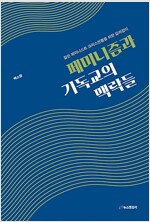

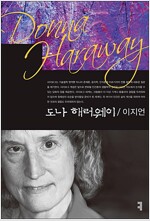
해러웨이의 『해러웨이 선언문』을 기다리고 있다. 추천글에 기대만발이었던 1인은 차례에서 <반려종> 선언을 보고 움찔한다. 해러웨이 생각하다가 아침에 해러웨이 만났다.
단순화시키는 감이 있지만 결국 이 패러다임은 ˝과학기술이 여성을 해방할 거다˝라고 선언하는 것이지요. 실제로 그래 왔어요. 여성해방을 외친 사상가들이 그동안 많았지만 정작 실질적인 여성해방은 가사 노동이 자동화되면서 가능해졌죠. 하지만 이 패러다임의 페미니스트들이 말하는 것은 우리 생활 도구의 기계화가 가져오는 편리함이나 시간과 노동력의 감소가 아니에요. 그동안 생물학적 몸에 갇혀 있었으니까 남자냐 여자냐 누가 높고 낮나 우월하나 열등하나 했던 것이지, 우리의 존재가 여자인지 남자인지 동물인지 자연인지 인간인지 기계인지 그 경계를 모르면 정체성을 규정할 수 없게 되죠. 포착되지 않기 때문에 비난도 지배도 할 수 없다는 것이 이런 '혼종성’ 담론을 지지하는 학자들의 주장이에요. 이항 대립적이고 위계적인 현 문명의 대항체로 ‘잡종‘을 선언한 것이죠. 대표적으로 도나 해러웨이(Donna Haraway, 1944~), 로지 브라이도티(Rosi Braidotti, 1954~) 등이 이 패러다임에 속하는 페미니스트예요. (93쪽)

